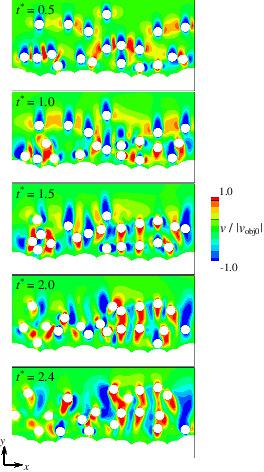当前位置:
X-MOL 学术
›
Int. J. Numer. Methods Fluids
›
论文详情
Our official English website, www.x-mol.net, welcomes your
feedback! (Note: you will need to create a separate account there.)
A simple collision algorithm for arbitrarily shaped objects in particle‐resolved flow simulation using an immersed boundary method
International Journal for Numerical Methods in Fluids ( IF 1.7 ) Pub Date : 2020-03-10 , DOI: 10.1002/fld.4826 Takayuki Nagata 1 , Mamoru Hosaka 2 , Shun Takahashi 3 , Ken Shimizu 2 , Kota Fukuda 2 , Shigeru Obayashi 4
International Journal for Numerical Methods in Fluids ( IF 1.7 ) Pub Date : 2020-03-10 , DOI: 10.1002/fld.4826 Takayuki Nagata 1 , Mamoru Hosaka 2 , Shun Takahashi 3 , Ken Shimizu 2 , Kota Fukuda 2 , Shigeru Obayashi 4
Affiliation

|
In the present study, we proposed a simple collision algorithm, which can be handled arbitrarily shaped objects, for flow solvers using the immersed boundary method (IBM) based on the level set and ghost cell methods. The proposed algorithm can handle the collision of the arbitrarily shaped object with little additional computational costs for the collision calculation because collision detection and calculation are performed using the level set function and image point, which are incorporated into the original IBM solver. The proposed algorithm was implemented on the solid‐liquid IBM flow solver and validated by simulations of the flow over an isolated cylinder and sphere. Also, grid and time step size sensitivity on the total energy conservation of objects were investigated in cylinder‐cylinder, cylinder‐red‐blood‐cells‐shaped (RBC‐shaped) objects, sphere‐sphere, and sphere‐flat plate interaction problems. Through validation, good agreement with previous studies, grid and time step size convergence, and sufficient total energy conservation were confirmed. As a demonstration, the drafting, kissing, and tumbling processes were computed, and it was confirmed that the present result by the proposed method is similar to the previous computations. In addition, particle‐laden flow in a channel including obstacles with collision and adhesion phenomena and the interaction of cylinders and wavy‐wall were computed. The results of these simulations reveal the capability of solving a flow containing arbitrarily shaped moving objects with collision phenomena by a simple proposed method.
中文翻译:

使用沉浸边界方法的粒子分解流模拟中任意形状物体的简单碰撞算法
在本研究中,我们提出了一种简单的碰撞算法,该碰撞算法可以使用基于水平集和幻影单元方法的浸入边界方法(IBM)为流求解器处理任意形状的对象。所提出的算法可以用任意少量的计算成本来处理任意形状的对象的碰撞,因为使用水平集函数和图像点执行了碰撞检测和计算,这已合并到原始的IBM求解器中。所提出的算法在固液IBM流量求解器上实现,并通过对孤立的圆柱体和球体上的流动进行仿真验证。此外,还研究了圆柱和圆柱的时空大小对物体总能量守恒的敏感性,圆柱-红血细胞-形(RBC-形)物体,球-球和球-平板相互作用问题。通过验证,与先前的研究,网格和时间步长的收敛性以及足够的总节能量得到了很好的确认。作为演示,计算了起草,接吻和翻滚过程,并证实了所提出的方法的当前结果与先前的计算相似。此外,还计算了包含碰撞和粘附现象的障碍物以及圆柱体和波浪壁相互作用的通道中的含颗粒流。这些模拟的结果表明,通过一种简单的拟议方法可以解决包含具有碰撞现象的任意形状的运动物体的流的能力。通过验证,与先前的研究,网格和时间步长的收敛性以及足够的总能量节省得到了很好的一致。作为演示,计算了起草,接吻和翻滚过程,并证实了所提出的方法的当前结果与先前的计算相似。此外,还计算了包含碰撞和粘附现象的障碍物以及圆柱体和波浪壁相互作用的通道中的含颗粒流。这些模拟的结果表明,通过一种简单的拟议方法可以解决包含具有碰撞现象的任意形状的运动物体的流的能力。通过验证,与先前的研究,网格和时间步长的收敛性以及足够的总节能量得到了很好的确认。作为演示,计算了起草,接吻和翻滚过程,并证实了所提出的方法的当前结果与先前的计算相似。此外,还计算了包含碰撞和粘附现象的障碍物以及圆柱体和波浪壁相互作用的通道中的含颗粒流。这些模拟的结果表明,通过一种简单的方法可以解决包含具有碰撞现象的任意形状的运动物体的流的能力。计算了接吻和翻滚过程,并证实了所提出的方法的当前结果与先前的计算相似。此外,还计算了包含碰撞和粘附现象的障碍物以及圆柱体和波浪壁相互作用的通道中的含颗粒流。这些模拟的结果表明,通过一种简单的拟议方法可以解决包含具有碰撞现象的任意形状的运动物体的流的能力。计算了接吻和翻滚过程,并证实了所提出的方法的当前结果与先前的计算相似。此外,还计算了包含碰撞和粘附现象的障碍物以及圆柱体和波浪壁相互作用的通道中的含颗粒流。这些模拟的结果表明,通过一种简单的拟议方法可以解决包含具有碰撞现象的任意形状的运动物体的流的能力。
更新日期:2020-03-10
中文翻译:

使用沉浸边界方法的粒子分解流模拟中任意形状物体的简单碰撞算法
在本研究中,我们提出了一种简单的碰撞算法,该碰撞算法可以使用基于水平集和幻影单元方法的浸入边界方法(IBM)为流求解器处理任意形状的对象。所提出的算法可以用任意少量的计算成本来处理任意形状的对象的碰撞,因为使用水平集函数和图像点执行了碰撞检测和计算,这已合并到原始的IBM求解器中。所提出的算法在固液IBM流量求解器上实现,并通过对孤立的圆柱体和球体上的流动进行仿真验证。此外,还研究了圆柱和圆柱的时空大小对物体总能量守恒的敏感性,圆柱-红血细胞-形(RBC-形)物体,球-球和球-平板相互作用问题。通过验证,与先前的研究,网格和时间步长的收敛性以及足够的总节能量得到了很好的确认。作为演示,计算了起草,接吻和翻滚过程,并证实了所提出的方法的当前结果与先前的计算相似。此外,还计算了包含碰撞和粘附现象的障碍物以及圆柱体和波浪壁相互作用的通道中的含颗粒流。这些模拟的结果表明,通过一种简单的拟议方法可以解决包含具有碰撞现象的任意形状的运动物体的流的能力。通过验证,与先前的研究,网格和时间步长的收敛性以及足够的总能量节省得到了很好的一致。作为演示,计算了起草,接吻和翻滚过程,并证实了所提出的方法的当前结果与先前的计算相似。此外,还计算了包含碰撞和粘附现象的障碍物以及圆柱体和波浪壁相互作用的通道中的含颗粒流。这些模拟的结果表明,通过一种简单的拟议方法可以解决包含具有碰撞现象的任意形状的运动物体的流的能力。通过验证,与先前的研究,网格和时间步长的收敛性以及足够的总节能量得到了很好的确认。作为演示,计算了起草,接吻和翻滚过程,并证实了所提出的方法的当前结果与先前的计算相似。此外,还计算了包含碰撞和粘附现象的障碍物以及圆柱体和波浪壁相互作用的通道中的含颗粒流。这些模拟的结果表明,通过一种简单的方法可以解决包含具有碰撞现象的任意形状的运动物体的流的能力。计算了接吻和翻滚过程,并证实了所提出的方法的当前结果与先前的计算相似。此外,还计算了包含碰撞和粘附现象的障碍物以及圆柱体和波浪壁相互作用的通道中的含颗粒流。这些模拟的结果表明,通过一种简单的拟议方法可以解决包含具有碰撞现象的任意形状的运动物体的流的能力。计算了接吻和翻滚过程,并证实了所提出的方法的当前结果与先前的计算相似。此外,还计算了包含碰撞和粘附现象的障碍物以及圆柱体和波浪壁相互作用的通道中的含颗粒流。这些模拟的结果表明,通过一种简单的拟议方法可以解决包含具有碰撞现象的任意形状的运动物体的流的能力。









































 京公网安备 11010802027423号
京公网安备 11010802027423号